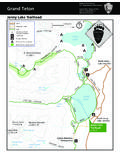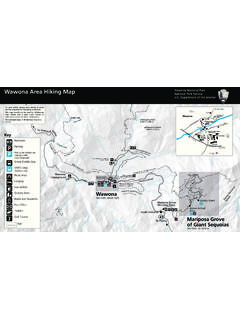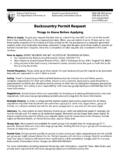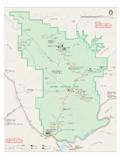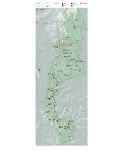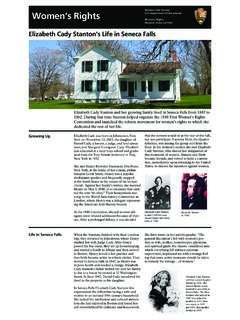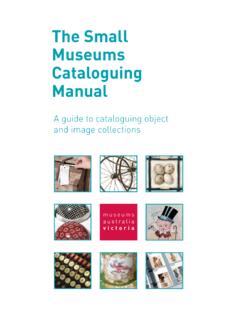Transcription of Chapter 8: Conservation Treatment - NPS
1 Chapter 8: Conservation Treatment Page A. 8:1 What is preservation and how is it accomplished? ..8:2 What is Conservation Treatment ? ..8:2 What is stabilization? ..8:3 What is restoration? ..8:3 Why use reproductions? ..8:4 Why should treatments be reversible?..8:4 What NPS guidance is available to help me make decisions about Conservation Treatment ? ..8:4 When do I need a conservator?..8:4 B. Factors to Consider Before Conservation Treatment .
2 8:5 How will I know what Conservation Treatment is appropriate? ..8:5 What guidelines should I follow when considering restoration? ..8:7 What is routine maintenance and how does it affect an object? ..8:7 C. Documentation of Conservation :8 Why is Conservation documentation important? ..8:8 What is the ICMS Conservation module?..8:9 What information can be recorded in the Conservation module?..8:9 What documentation should the conservator provide?.. 8:10 What documentation steps are taken when an object is treated? ..8:12 What kinds of documentation should park staff generate on its own Treatment activities?
3 8:13 D. Obtaining the Services of a Conservator ..8:13 How do I find a conservator? ..8:14 How do I decide if a suggested conservator and Treatment are suitable?..8:14 What do I need to know about contracting for Conservation Treatment services? ..8:15 Should the Treatment be performed on-site or off-site? ..8:16 How do I work with an NPS conservator?..8:17 When I evaluate a Treatment proposal, what should I consider? ..8:17 What insurance coverage should the conservator have? ..8:17 What happens after the conservator is selected?..8:18 What are my responsibilities once the Treatment proposal is approved?
4 8:19 Where can I find information on how to treat objects in an emergency? ..8:19 E. Glossary ..8:20 F. Selected :21 G. Web :21 List of Figures Figure Information Required in Conservation Treatment Documentation ..8:11 Figure Sample Scope of Work for Conservation Treatment ..8:23 Figure Sample Insurance and Copyright Requirements for Inclusion in a Contract ..8:27 Figure Sample Object Examination Report ..8:28 Figure Sample Object Treatment Proposal ..8:30 Figure Sample Object Treatment :32 Chapter 8: Conservation Treatment A.
5 Overview This Chapter explains what Conservation Treatment is, when it is appropriate, and how to obtain the services of a professional conservator. Care of NPS museum collections is based on a preventive Conservation approach (See Chapter 3: Preservation: Getting Started for more information). A good preventive Conservation program minimizes the need for Conservation Treatment . However, preventive measures are sometimes inadequate and interventive Conservation Treatment performed by a conservator is necessary to help preserve an object: If an object has inherent vice and preventive measures are insufficient to reduce the rate of deterioration to a tolerable level, an appropriate Conservation Treatment can prolong the life of an object.
6 For example, a paper conservator can wash deteriorated wood-pulp paper to remove acidic by-products. If an object is extremely fragile due to advanced deterioration, appropriate Conservation Treatment can increase its stability and durability. For example, a paintings conservator can re-attach flaking paint. If an object is to be used for exhibit, research, or publication, Conservation Treatment may be needed. For example, a textile conservator may construct a special mount for a flag to allow it to be exhibited vertically, or an archeological conservator can clean a metal artifact to reveal important markings.
7 Conservation Treatment is hands-on, alterative ("interventive") work performed in order to preserve and/or restore objects. Only trained conservators who have experience in the appropriate material (such as paintings, textiles, furniture, photographs, books, paper, archeological objects, ethnographic objects, natural history specimens) should perform Conservation treatments on objects. If Conservation Treatment is required, the park staff must ensure that: objects, archives, and specimens receive the most appropriate Treatment for their continued preservation and use Treatment is appropriate and takes into consideration an object's condition, history, significance, and use(s) treatments are performed by skilled, experienced conservators and properly documented NPS Museum Handbook, Part I (2012) Conservation Treatment 8.
8 1 1. What is preservation and how is it accomplished? Anyone who carries out a Treatment on NPS museum collections must agree to follow the principles and practices specified in the Code of Ethics and Guidelines for Practice of the AIC (American Institute for Conservation of Historic and Artistic Works, 1994).
9 Refer to Appendix D for a copy of the Code of Ethics. Include this requirement in all contracts. NPS policy emphasizes preservation. Management Policies, Section states that an item in a museum collection will be preserved in its present condition through ongoing preventive care if: that condition is satisfactory for exhibit or research; or another Treatment is warranted, but it cannot be accomplished until some future time. Preservation encompasses all actions taken to prolong the life of an object. 2. What is Conservation Treatment ? Ongoing preventive Conservation (preventive care) is always the preferred way of ensuring preservation of museum collections.
10 Conservation Treatment carries inherent risk and is generally more resource and time intensive. However, if preservation cannot be satisfactorily accomplished through preventive Conservation , interventive measures ( Conservation Treatment ) may be considered. After a Conservation Treatment is carried out, treated objects should be returned to storage or exhibition conditions that reflect good preventive Conservation practices. If objects are returned to substandard conditions, they cannot be effectively preserved. Many of the chapters and appendices of the Museum Handbook, Part I, contain additional information on collection preservation, including establishing a good preventive Conservation program.



